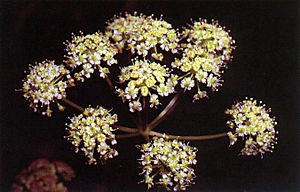Western water hemlock facts for kids
Quick facts for kids Western water hemlock |
|
|---|---|
 |
|
| Scientific classification | |
| Genus: |
Cicuta
|
| Species: |
douglasii
|
Cicuta douglasii, also known as the western water hemlock, is a very poisonous plant that belongs to the Apiaceae family. It's a perennial plant, meaning it lives for more than two years. You can find it growing in wet areas like marshes, stream banks, ditches, and wet fields. Its roots are thick and can store water, helping it survive in these damp places. Western water hemlock is most common in British Columbia, Canada, and is native to North America. It grows mainly from the Rocky Mountains all the way to the Pacific coast, from Alaska down to California. Because it needs a lot of water, it doesn't grow in dry, open areas.
Contents
What Does Western Water Hemlock Look Like?
Western water hemlock has some unique features that help identify it.
Stems and Leaves
Its stem can grow quite tall, from about 0.5 to 2 meters (about 1.5 to 6.5 feet) high. The stem often has purplish spots. The plant has thick roots and leaves that grow alternately along the stem. These leaves are "compound pinnate," which means they are made up of many smaller leaflets arranged like feathers. Each leaflet is usually about 5–8 centimeters (2–3 inches) long and 1–2 centimeters (0.4–0.8 inches) wide, and they have jagged edges.
Flowers and Seeds
The flowers of the western water hemlock are small and white, growing in clusters that look like umbrellas. Each flower produces two seeds. These seeds can spread in many ways: by wind, water, farm machinery, clothing, or even in transported soil. New plants usually start from seeds in the spring. The flowers bloom around late June and early July.
How Western Water Hemlock Reproduces
Besides growing from seeds, western water hemlock can also grow new plants from its roots. In the fall, new plant parts can start to form from the base of the root system. These new parts can break off the following spring and grow into completely new plants. This helps the plant spread easily in wet environments.
Why Western Water Hemlock is Dangerous
The most important thing to know about western water hemlock is how incredibly poisonous it is. It's considered the most poisonous plant in North America.
The Toxin: Cicutoxin
The plant produces a powerful toxin called Cicutoxin. This toxin is a yellowish liquid found mostly in the roots. Cicutoxin seriously affects the central nervous system of animals and humans.
Symptoms of Poisoning
If someone or an animal eats western water hemlock, symptoms can appear very quickly. Early signs include a lot of drooling, foaming at the mouth, nervousness, and trouble moving normally. These symptoms can quickly get worse, leading to shaking, muscle weakness, seizures, and even difficulty breathing.
For humans, eating even a tiny amount – about 0.1% of a person's body weight – can be deadly. For animals, it takes even less. For example, as little as 0.2–0.5% of a sheep's body weight, or 0.1% of a cow's body weight, can be fatal. Death can happen within just 15 minutes of eating the plant.
Why It's a Risk
Western water hemlock is one of the first plants to grow in the spring, and it has a smell that can seem appealing. These features, along with the fact that it grows in wet areas where grazing animals might be, make it very attractive but deadly to animals like sheep, cattle, horses, and pigs. It's crucial to be able to identify this plant and avoid it.
See also
- Poisonous plant
- Toxin
- In Spanish: Cicuta douglasii para niños

